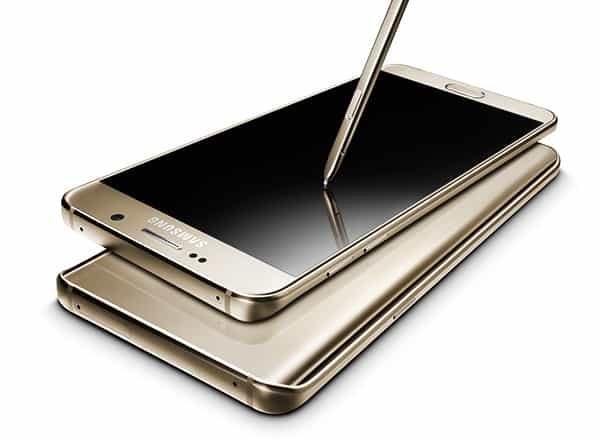
Above: Samsung’s Note 5 includes a stylus and apps that support its use. Photo courtesy Samsung.
BitDepth#1022 for January 05, 2016
Samsung, with the Note 5, has refined the big smartphone to quite a lustre.
None of the previous models of the phone have been particularly bulky, despite their commanding screen size, but the fifth version of the device feels particularly svelte.
I do have a different experience than most users will with the larger version of Samsung’s premium S series line of smartphones, having a larger than average palm into which the phone can nestle and much bigger pockets to shove one into.
The Note line has, to my ongoing surprise, found avid fans among fashionable women in my informal and deeply curious personal survey of where it tends to crop up.
Among those users, the device is less a large phone than it is a small tablet, an all-in-one communication tool that delivers optimum bang per square inch in a ram-cram ladies’ pocketbook.
I’m not sure I’d be as keen about the Note 5 after bulking it up with an appropriate protective case, but as designed, it’s an eminently sleek phone to slip into even a tight jeans pocket.
I currently use an S6, and there’s really no case to be made for upgrading from that model to the Note 5.
Both phones are functionally identical. The Note 5 is bigger and weighs in at 178g versus 138g for the S6, a difference that’s impossible to notice in day to day use, particularly after you’ve put the devices into a protective sheath.
Speed of execution, responsiveness, and user experience are identical and Samsung has been quietly improving the size and fidelity of its S series screens to the point that going from one phone to another is seamless.
Which is not to say that the larger screen is unnoticeable.
The effect is subtle. Both screens sport the same number of pixels, 2560 x 1440 of them, but more are crammed into the S6 screen per square inch at 577ppi versus the Note 5’s 518ppi.
So you can’t fit any more icons on the home screen, but everything is just that much bigger.
I’m writing the first draft of this column in Evernote on the Note 5 and even without SwiftKey, my preferred keyboard enhancement, the slightly larger virtual keyboard registered fewer missed keystrokes than normal.
You can use bigger text in an e-reader (I like Moon Reader) and fit more readily scanned chunks of text on screen.
In short, or more accurately in large, using the Note 5 offers some virtual elbow room you probably didn’t know you needed.
Battery life tracks closely with the S6, running for around 30 hours with active Bluetooth and 4G Internet, but dropping as you add active functions like music playback, tasking the radio often for web browsing or keeping the screen active for reading.
This is a bigger phone than the S6, with a commensurately larger and more fragile screen (sorry, but that’s just physics), so the Note 5 demands some kind of protective case and that’s going to inevitably bulk up the device in ways that aren’t part of Samsung’s plan for its design.
That brings us back to the ongoing challenge with larger smartphones. Is the bigger screen size worth the other compromises that go along with a bigger device?
Ultimately, it’s a decision that your use patterns and personal preferences will decide for you, but as a working smartphone pressed into use as a replacement for my S6, the Note 5 proved to be a very comfortable and tempting alternative.


